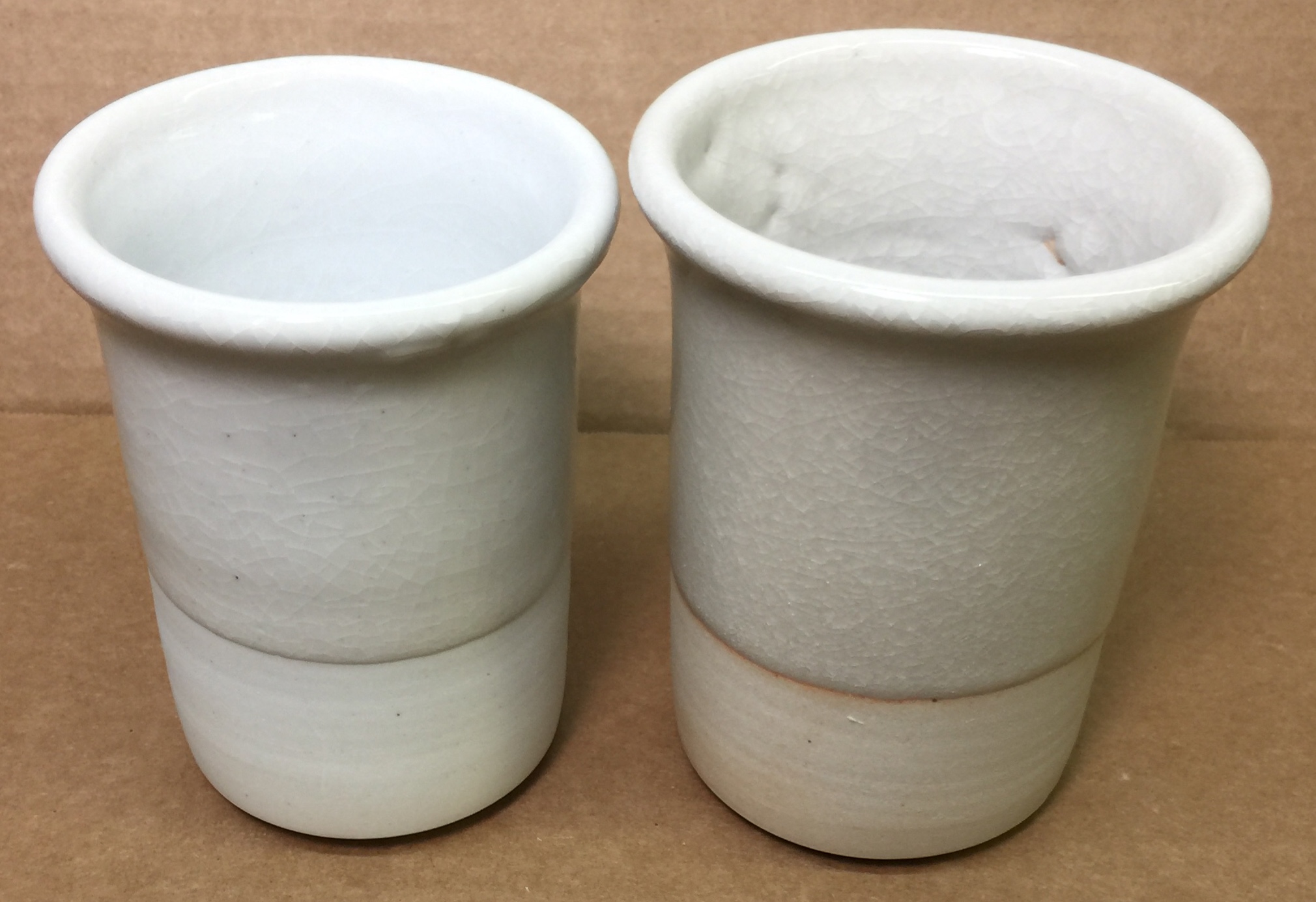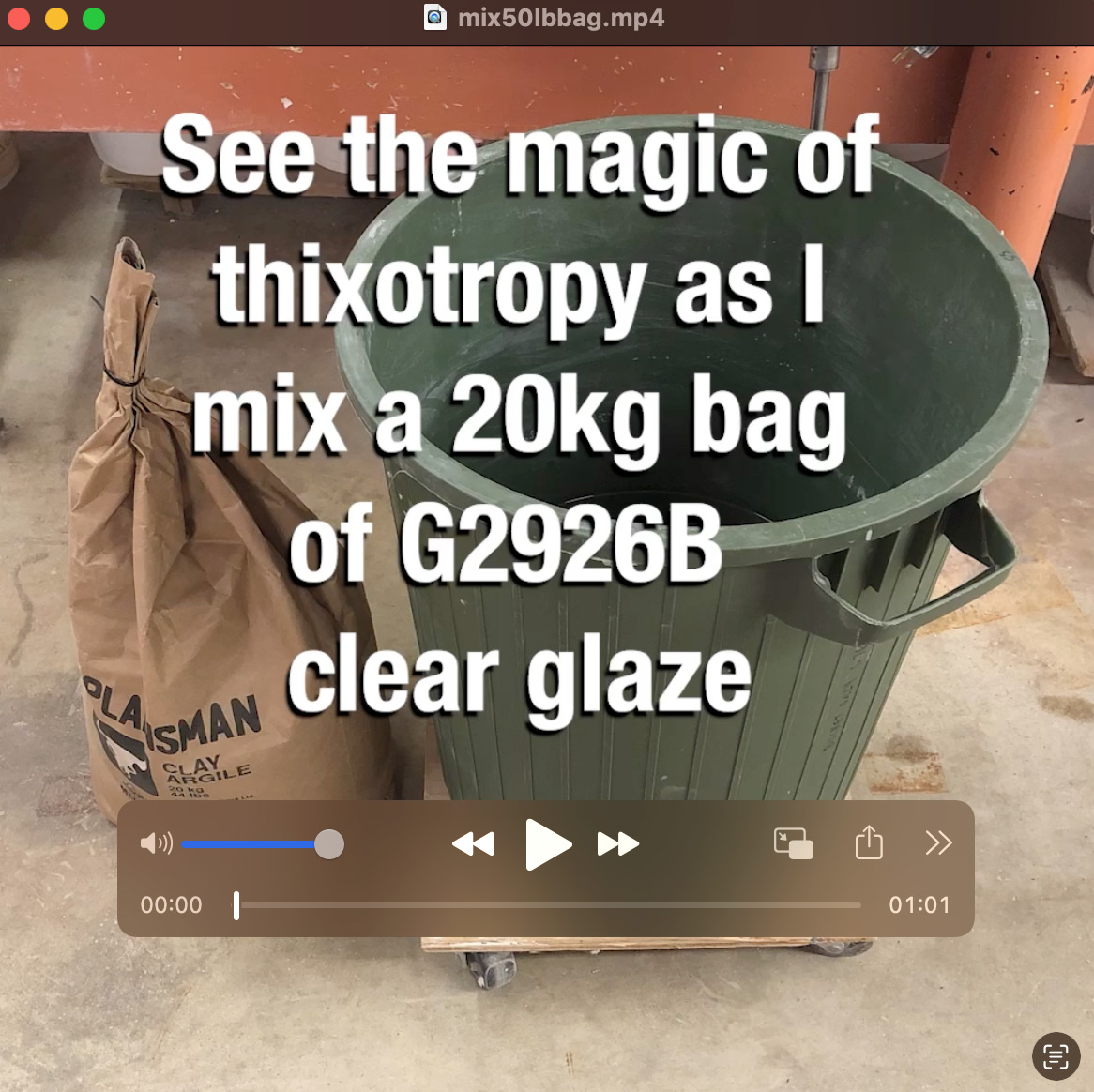| Monthly Tech-Tip | No tracking! No ads! | |
Pure feldspar applied as a glaze: Possible because of the magic of thixotropy.
These are pure Custer feldspar and Nepheline Syenite. The coverage is perfectly even on both. No drips. Yet no clay is present. The secret? Epsom salts. I slurried the two powders in water until the flow was like heavy cream. I added more water to thin and then started adding the Epsom salts (powdered). After only a pinch or two, they both gelled. Then I added more water and more Epsom salts until they thickened again and gelled even better. The result is a thixotropic slurry. They both applied beautifully to these porcelains. The gelled consistency prevented them from settling in seconds to a hard layer on the bucket bottom. Could you do this with pure silica? Yes! The lesson: If these will suspend by gelling with Epsom salts, then any glaze will. You never need to tolerate settling or uneven coverage for single-layer dip-glazing again!
Related Pictures
Suspending pure feldspar and applying it as a glaze

This picture has its own page with more detail, click here to see it.
Most people think that would be impossible. But it is not. This slurry will stay in suspension for days. How? It is flocculated using a tiny bit of powdered epsom salts. Without the epsom salts it is watery and will settle in seconds. How does the slurry apply to this porcelain? Since it contains no clay it has complete permeability. Against the immersed bisque a layer builds very rapidly, pieces must be dipped and removed immediately. Does it dry hard enough to handle? Yes.
Craze city: Feldspar and Nepheline Syenite on cone 10R porcelain bodies

This picture has its own page with more detail, click here to see it.
These were applied to the bisque as a slurry (suspended by gelling with powdered or dissolved Epsom salts). On the left is Custer feldspar, the right is Covia Nepheline Syenite. Notice the crazing (feldspars, and nepheline syenite, always craze because they are high in K2O and Na2O, these oxides have by far the highest thermal expansions).
See the magic of thixotropy as I mix a 20kg batch of G2926B glaze
In this video, I mix 20kg of G2926B glaze powder into 20kg of water using our powerful propeller mixer. The resulting slurry is like water, absolutely unusable. Yet on measuring the specific gravity (using a hydrometer because it floats freely) I find that it is too high, I actually have to add more water! How is that even possible? Instead, I add Epsom salts and mix again and the slurry gels and hangs on in a perfectly even layer when I dip the spatula. This is a thixotropic gel, it will apply evenly to bisque ware yet not go on too thickly. We normally recommend a specific gravity of 1.44 for this glaze, but in this case, it seemed watery enough at 1.46 (on use, it will become clear if 1.46 is OK e.g. if it goes onto the ware too thick). If that happens I'll just add water to 1.44 (and more Epson salts if needed). Based on online pricing at this time, coverage is minimum six times and as much as twenty times less expensive than buying jars of transparent brushing glaze (considering both the total powder weight and the specific gravity difference between this and commercial glazes we use).
The engobe on this stainless steel spoon has not cracked in drying or firing. How?

This picture has its own page with more detail, click here to see it.
This spoon was dipped into a ceramic dipping engobe, L3954B. It contains no CMC gum, it was only flocculated using powdered Epsom salts. Without the Epsom salts, the engobe runs off, leaving only a film. But, when turned into a thixotropic slurry, it stays on the spoon in an even layer (as a gel), then hardens as it dewaters (left) and finally dries completely (right). With no cracks! It also fires to cone 03 with no cracks. Of course, if this were fired high enough, it would begin to shrink, crack, crawl, melt and then craze, ceasing to be an engobe. Of course, special low-expansion frits and additives and mixing, preparation and application techniques make enamels, which do melt, possible for metals.
Videos
 |
Watch Thixotropy Happen With a 20kg Batch of Dipping Glaze
I mixed 20kg of glaze powder into 20kg of water, turned out super watery. Yet the specific gravity was 1.46, too high. How? But, instead of more water, I added Epsom salts—and boom: A perfect thixotropic gel. It glides on smooth, no drips, no thickness issues. |
Links
| Troubles |
Powdering, Cracking and Settling Glazes
Powdering and dusting glazes are difficult and a dust hazard. Shrinking and cracking glazes fall off and crawl. The cause is the wrong amount or type of clay. |
| Glossary |
Thixotropy
Thixotropy is a property of ceramic slurries of high water content. Thixotropic suspensions flow when moving but gel after sitting (for a few moments more depending on application). This phenomenon is helpful in getting even, drip-free glaze coverage. |
| Materials |
Epsom Salts
|
Got a Question?
Buy me a coffee and we can talk

https://digitalfire.com, All Rights Reserved
Privacy Policy

